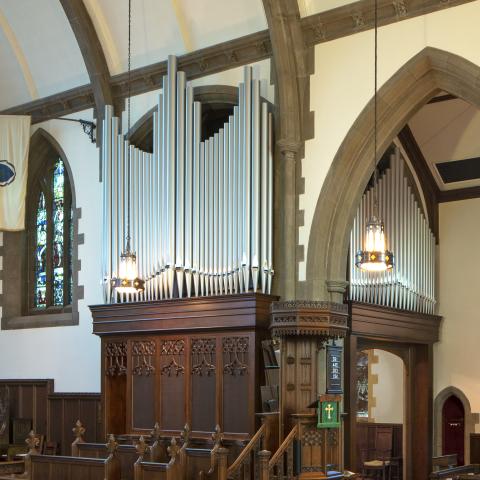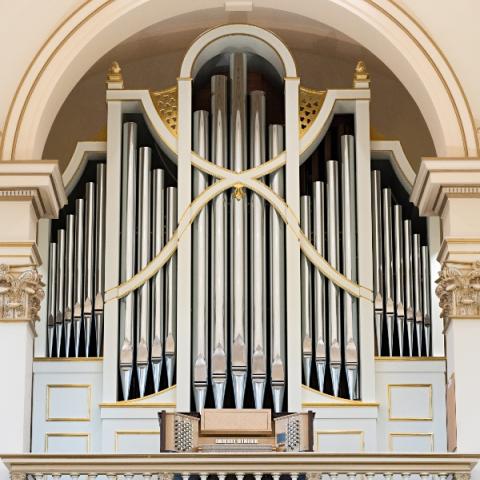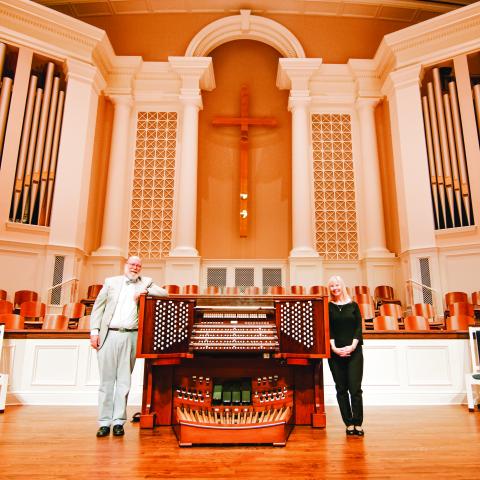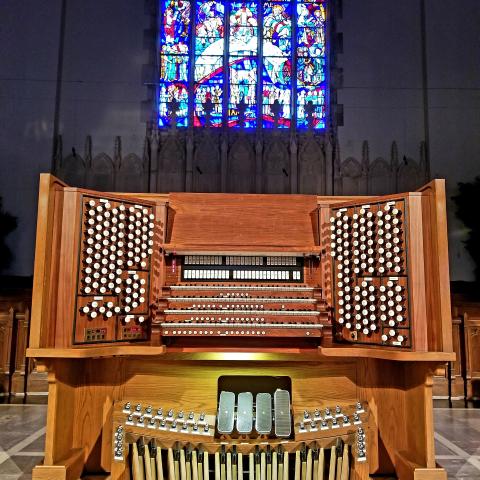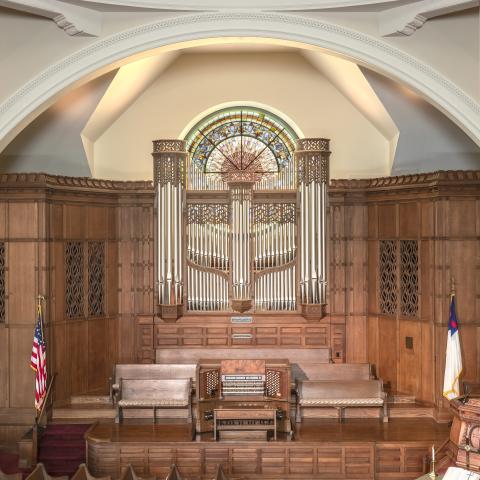Born in Insterburg, Germany, Gerhard Grenzing trained in organbuilding with Rudolf von Beckerath in Hamburg, and gained further qualification by working with several other European workshops, mainly in Austria and Switzerland.
Beginning in 1967, he restored several organs in Majorca. In 1972, he set up his own workshop in El Papiol, near Barcelona, Spain. Approximately 250 new and restored organs have left the Grenzing workshop for Spain, France, Germany, Portugal, Belgium, Switzerland, Austria, Denmark, Italy, Sweden, Japan, South Korea, Bogotá, Brazil, Uruguay, Mexico, and Russia.
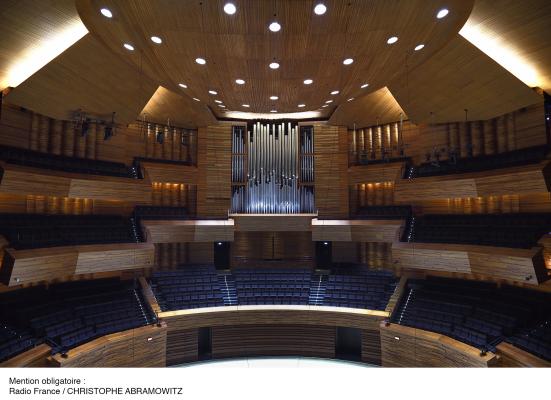
Since its founding in 1975 Radio France has remained the sole public radio broadcaster in France. The sprawling premises in the 16th arrondissement, occupied by the station from its inception, have been enhanced by a new 1,461-seat concert hall. However, in the design by the Parisian architectural bureau AS Architecture-Studio with acoustic consulting by the renowned firm of Nagata Acoustics from Japan, no organ was foreseen at the outset.
Only with a spirited campaign by dozens of leading figures in organ circles and the music world at large did the authorities eventually become convinced that in an organ city the likes of Paris and in a room like this one, a one-of-a-kind concert-hall organ must not be lacking. The attention that was aroused in this way spurred Radio France to have the organ project overseen by a committee of six organists, made up of Michel Bouvard, Thierry Escaich, François Espinasse, Bernard Foccroulle, Olivier Latry, and Jean-Pierre Leguay.
Once our firm had been awarded the contract for building the organ, and subsequent to an international call for tenders, we were actively supported and stimulated by the committee during the total of six years that the design phase, execution, and finishing were to last. The intense dialogue that came about among us as organbuilders and these experienced specialists was extraordinarily enriching and has already become a significant basis for future offshoot projects.
When I began to build organs in Barcelona, Spain, in the 1970s my work was quickly noticed in France and acknowledged with important contracts there. The company leadership in the Grenzing firm has meanwhile been transferred to my daughter Natalie Grenzing, seconded by the German master-organbuilder Andreas Fuchs. My sixty years’ knowledge is always appreciated. Our particular responsibility for the realization of the Radio France concert hall organ was shared by our entire team, consisting of twenty seasoned collaborators from seven nations.
Hallmarks of an organ for a concert venue
How, then, does a concert hall organ differ from its sibling in a church? It needs to feature a formal and coloristic relationship to all the tone colors of our instrumental and vocal musical culture. From a wafting pianissimo to the most massive fortissimo it should accompany, enhance, and provide the foundation for soloists, choirs, a chamber orchestra, and the large symphony orchestra. It should be capable of fulfilling its role in the orchestral literature and serve in the various styles of organ repertory. Finally, composers and improvisers should construe such an organ as an inspiring and subtly appointed medium for new works.
In May 2010, following the awarding of the contract, a meeting was held with the committee, in which, with the participation of six collaborators from our team, the technical and especially the tonal conceptions as well as the design of the consoles and accessories were discussed and voted on. It was only in this meeting that, through creative interplay among all those participating, the definitive specification and the technical details of the organ were determined; some among them were decidedly innovative. Several registers are located on an auxiliary windchest, so that they can be used in the Grand-Orgue as well as in the Pedal.
In many aspects of designing this organ we broke new ground tonally and technically. To our knowledge, for example, there exists no other instrument that may be played simultaneously from an electric console with proportional action and from a mechanical console. Our idea of a three-rank Gamba chorus with 4′ extension was accepted. For this we envisioned a bright tone color, almost as a preliminary stage leading up to the use of high mutations or mixtures.
Our wish to have variety in the area of reeds was received favorably as well. Thus not only was a chamade instituted but also a high-pressure division with tubas, which—enhanced by high-pressure flutes—sets the instrument off against the orchestra or, with its “broad shoulders,” underpins the same. Similarly, the Cor anglais in the Solo division, for example, was developed with a particular color for solo work.
We understand that French ears have a predilection for the sound of the indigenous French reed stops. As a result of our studies we are constantly aware in what country and for what ears we are creating (or, even more important, restoring) sounds. Hence a careful distinction was made between reed stops in the German style—which, versatile in their combination possibilities and together with the flues yielding various vowel sounds, can be used polyphonically—and the reed stops usual in French organs. The names of these stops make them recognizable by the wording, such as Trompete as opposed to Trompette.
The organ casework was designed by the architect of the hall, taking our technical/stylistic specifications into account. The instrument is thus so integrated into the hall that it comes across not so much as a distinct body but above all by virtue of the huge, 12 meter by 12 meter organ façade.
Our technical designer succeeded in fitting the eighty-seven registers with their 5,230 pipes into a depth of only some 3.84 meters, yet with a sense of order and clarity. In the foremost row of the façade stand the 8′ and 4′ pipes of the Grand-Orgue and Pedal, then just behind them the corresponding 16′ pipes, which fill up the entire space of the central case image.
The austere basic outline is relieved by the array of pipe ranks in a free play of pipe sizes and foot lengths. The swell shades framing the façade symbolize in three levels the enclosed divisions of the first, third, and fourth manuals, which opens up on a glimpse of the pipes standing behind. The effect, further enhanced by lighting setups, lends a dynamic visual dimension to the organist’s playing. This lighting function may of course be turned off.
The case pipes, in typical Spanish fashion, are polished with a scraper applied perpendicular to the pipe body. Together with the multi-faceted artificial illumination an enlivening effect of subtle contrast with the pipe bodies is achieved, which in neutral light is transformed into a gossamer sheen.
The main façade is formed by pipes. Next to it are found the visible swell shades, and to the outside on either side the pedal, which is masked by acoustically transparent fabric.
The console arrangements
The mechanical-action attached console features a visual link to the conductor via a screen and a mirror. Both can be slid into the case. Special functions of the console include:
• four adjustable crescendos that may be assigned to any of the swell pedals;
• a cumulative device for all enclosed divisions (“All Swells”);
• for the manual couplers, mechanical or electric action may be selected;
• a MIDI replay and tuning system;
• freely adjustable interval couplers (prepared for; you can chose any interval—for example a third, fifth, ninth, or any other “strange” interval—for coupling to any manual and thus enrich the color of registration);
• freely adjustable divided pedal couplers (prepared for).
The mobile console on the orchestra plateau is equipped with proportional electric action (sensitive touch).
A tracker organ with refined touch-sensitive action enables the organist to control the crucial attack and release parameters of the pipe speech, the only way the potential for musical expressivity can be realized by means of the corresponding reaction of the wind. With a normal electric action this is not possible, since only an on/off contact is involved. On the other hand, proportional electric action accurately conveys the movement of the fingers to the pallets in the windchest. Even a pedal tone, which the organist has such a hard time controlling at a large instrument, can henceforth be given a surprisingly slow sound decay.
Particular features of the mobile console include:
• transparent design, with no pedestal of its own, thereby being extremely low-lying and easily movable;
• all divisions can be assigned to various keyboards, meaning an inversion between Grand-Orgue/Positif and Récit/Solo, e.g., Grand-Orgue on the first manual, the Positif on the second or vice-versa;
• the “point of contact,” that is the exact place within the keydrop at which the note sounds or cuts off, can be adjusted;
• the lateral position of the pedalboard can be variously adjusted, for example C2 under manual C3 or D2 under manual C3.
Features common to both consoles:
• both consoles have four 61-note manual keyboards that are capped with bone and ebony. The pedalboards with 32 keys are made of oak. Via the touchscreen the organist can store personal files or, for example, adjust the speed of the tremolos;
• the key sostenuto functions either as an addition (that is, all depressed keys continue to sound) or as a substitution (the previously depressed keys are cancelled when new keys are depressed). When one of the two functions is activated, it is cancelled by activation of the other function;
• both consoles can be played simultaneously. Priority for the respective registration can be assigned at will to the mechanical or to the electric console.
Further particularities:
• there is a sequencer with wireless remote control for the assistant, so that the organist is not inconvenienced;
• USB memory sticks can be used for personal data;
• via a decimal keyboard (like a telephone keyboard) and a touchscreen the combination action in its versatile modes of utilization is memorized. Thousands of combinations can be called forth. Various combinations and levels are accessible only by means of a code. Organists can rest assured that they will truly have their combinations available to them.
Tonal considerations
We exchanged views extensively with composers, conductors, and organists (especially with organist-conductors) over tonal conceptions and once again express our thanks for the patient exchange of debate on this important subject. Often the remark was made that conductors ask organists to reduce the registration more and more, as the organ is one way or another too intrusive. We believe that this intrusiveness may be attributed in the pianissimo realm to the attack, the transient speech process (Einschwingvorgang) of each pipe, and in the forte realm mainly to the “organ-typical strident” tone of the mixtures, being too set apart from the tone color of the orchestra.
For a long time now we have felt confident in having recognized the solution in the most thoroughly refined attack behavior of each pipe. Despite its initial emission, at once quick and gentle, each tone should develop freely and in an unforced way. Thereby a certain “merging” into the sound of the orchestra can be furthered. Olivier Latry expressed the same idea in the symposium (see Appendix: A symposium on the concert hall organ).
Typical organ tone is to a very significant extent produced by mixtures and their quint ranks. For this reason we set the unison ranks in the Grand-Orgue mixture apart. The quints are then available via a separate register.
As a contrasting function there is in the Grand-Orgue a Cymbal with freely adjustable intervals. The sound can thereby be registered in the most varied colors as well as in the manner of actual Cymbals, but particularly as Ninths and Septièmes, whereby the organ, even in the midst of a triple forte in the orchestra, remains audibly distinct.
The instrument is divided into seven tonal groups in all that can either correspond with each other or be set off soloistically: Grand-orgue, Récit expressif, Positif expressif, Solo expressif, Solo Haute Pression [high-pressure] expressif, Chamade, and Pedal.
As an unusual tonal effect, in the Positif a wind pressure is available that is progressively modifiable by means of a separate swell pedal. As opposed to the standard wind cutoff this has the advantage that the manipulated pipe tone of all stops in this division remains less out-of-tune and better supplied, as not the quantity but only the pressure of the wind flow is changed.
From November 7 to 9, 2013, there was an initial, in-depth examination by the commission of the almost fully set up organ in our generously proportioned erecting room. For the first time in the large room with its 17 meters height and acoustics acclaimed for their high quality, the experts were able to play the instrument, exploring its features and discussing it with us. It thus seemed appropriate to organize the first concerts on the next day, followed by a symposium entitled “Organs in Concert Halls.” The members of the commission offered the concert, allowing as well the possibility of a discussion among some eighty specialists we had invited from throughout Europe (see https://www.youtube.com/watch?v=Xw1D5i_luFA; www.youtube.com/watch?v=YtagKK0VALo; and the summary of the discussion in the appendix).
Installation of the organ in Paris and its tonal characteristics
Following erection of the organ and the first on-site tests, the instrument was optimally adjusted to the room. We were eager, as a challenge from the outset, to take on the dauntingly dry acoustic of the hall. Once again, the instrument had to be adjusted to the tonal power of the orchestra, without relinquishing the tonal poetry and subtleties of the various colors and dynamic levels. We were most grateful indeed for the close collaboration and numerous instructive and supportive moments spent with the organists of the commission, in particular Olivier Latry.
From May 7 to 9, 2016, Radio France hosted dedication concerts with fifteen organists whose programs ranged from family concerts, a “Poetry and Organ” program, and one of improvised Andalusian-Arab music, to the avant-garde. The performers were Pascale Rouet, Coralie Amedjkane, David Cassan, Guillaume Nussbaum, Freddy Eichelberger, Juan de la Rubia, Lionel Avot, and Els Biesemans. The crowning final concert featured organists Michel Bouvard, Thierry Escaich, François Espinasse, Olivier Latry, Shin-Young Lee, and Jean-Pierre Leguay on May 9. You can hear the program on the internet at https://www.youtube.com/user/GerhardGrenzing.
Radio France intends to put the newly created instrument to use in highly multifarious ways. A campaign has been undertaken for the founding of a circle of patrons and donors committed to future activities focusing on this organ. The idea has been broached for workshops and study trips, public masterclasses, promotion of young titular organists, organ and cinema, a cycle of radio plays with France Culture, as well as a composition contest. Since Radio France records all its concerts, thorough maintenance of our instrument is important: it is carried out by our Parisian colleague Michel Goussu.
My heartfelt thanks for the confidence and the patient, consistently professional collaboration goes out to the six organists of the Radio France organ commission, the construction director Nadim Callabe, the conservator (or curator) of the organ Jean-Michel Mainguy, and most particularly the twenty collaborators on my staff.
I have in gratitude dedicated the success of the project to my master teacher Rudolf von Beckerath, who came as an apprentice to Paris and went away seven years later with knowledge to impart, and to our collaborator and friend Andreas Mühlhoff, who departed from us in sorrowful circumstances.
Perspectives
Following completion of the instrument one is beset with many thoughts: wherefore this effort? In the course of the last turn of the century the question was often asked: What will become of the organ in the future? Aware that the organ is the most evolution-prone of instruments, one could answer the question about its future development that the organ adapts to the needs and the spirit of the society of its time. Or, better put, it expresses it as a kind of mirror. But what is indeed our Zeitgeist of today?
Perhaps this: more and more we are determined by today’s technology. Our entire doings must occur ever faster. We want to have everything that can possibly be had. Even acknowledging that what seems modern today will already be outdated the day after tomorrow, we cannot simply exit this cycle. As was remarked at the end of the symposium, it seems to me that observance of musical ethics provides guidance in value boundaries.
In our shop we give full rein to the most novel technical developments and further enhance them. We are nevertheless very careful not to let ourselves be distracted, cultivating or incorporating noble, time-tested musical values.
Appendix: A symposium on the concert hall organ
We value any opportunity for enhancing the exchange of ideas. The Barcelona airport is located only twenty-five minutes away from our shop. Our slogan, “We are not far away, but rather neighbors,” was once again confirmed. On November 8, 2013, a symposium on concert hall organs was held in our shop. The impetus came from the new organ for Radio France, which at that time was nearly completed and set up in the shop. Thanks to the spontaneous initiative of our collaborators, the space occupied by our restoration division was converted into a standing buffet restaurant. The symposium was followed by two further days with public children’s concerts, a jam session, and a concluding silent film with Juan de la Rubia as improvising organist.
Summary of the symposium on November 8, 2013, in El Papiol
Bernard Foccroulle opened the symposium and noted the lack of organs in concert halls in France. The new instrument should serve the needs of Radio France and the two orchestras that perform there.
Olivier Latry expressed his regret that, for the most part, organs in concert halls do not live up to the expectations of musicians, orchestras, and conductors. The reason: the organs are often designed in the style of a special era or in the particular style of a given organbuilder. An example thereof is the wonderful organ in Taiwan with its sixty stops. Playing it requires two assistants, and very little literature is playable on the tracker instrument.
An instrument of lesser beauty will seldom be played. A few organs have been restored and brought up to date (for example, the Gewandhaus in Leipzig), and are played thirty-five to forty times each year.
In the Radio France complex an all-encompassing project needed to take in not only the organ but also the hall, the construction in general, and the acoustics. An organ cannot sound good in just any acoustic. Hence the need for the collaboration of an acoustician.
What are the particularities of a concert hall organ? Conductors often blame the organ either for being too loud (thereby overpowering the orchestra) or too soft (thus being covered up by the orchestra). The organ must possess a wide dynamic range. The multiplicity of sounds and transient attack parameters of the orchestral instruments bring about synchronization problems with the organ. Hence the necessity of a sound with cautious attack that can thereby come about with a kind of inertia. The sound of the organ must be capable of entering more or less slowly. The Radio France instrument meets this criterion; to this are added dynamic enclosed divisions, mechanical action, as well as the proportional electric action.
Olivier Latry emphasized that the collaboration of all the organists involved in the project was highly useful. Michel Bouvard noted that the comprehension of the various authorities at Radio France made it possible to enlarge the specification, such that the organ can serve not only as an organ for orchestra (and accompaniment for choir and children’s choir), but also as a solo instrument.
Gerhard Grenzing explained that the new organ is not an orchestral organ but should be an organ for the orchestra. This implies a refined voicing style and individually cultivated attack of each pipe. He emphasized the dynamics of the swell boxes, of the very soft stops for the accompaniment of the room-filling soloists, and of the very loud stops that—without succumbing to vulgarity—are meant to give the instrument “broad shoulders.” This makes it possible to respond to the orchestra without lording over it.
This is the result of many considerations shared among conductors and organists, for which Grenzing expressed his gratitude once again, as well as of the work of his team that contributed its sensitivity, perseverance, and soul to the cause, without which success would not have been possible.
Michel Bouvard shared his experience as director of the Toulouse les Orgues festival. In Toulouse a considerable richness in organs is available, but even if the ten best organists in the world had been invited that would not have been enough; in ten years the audience would have become weary of the same basic fare, and so numerous innovative programs and activities enriched the festival offerings. The high level of the concerts was maintained. Bouvard holds great hope for the same success at Radio France.
The organ must be brought “out of the chapel” in order to create momentum for a new public; a new place in music history must be found to lend it a new role of its own, and not only as a church instrument. It is important to gain a young audience through educational endeavors, for which models exist in the world, for example the Philharmonie in Budapest. Another possibility would be to organize “cinema concerts.”
Olivier Latry underscored Bouvard’s suggestion and reported on his experience in Manchester. There he was asked, as a prelude to Mahler’s Eighth Symphony, to improvise for twenty minutes on Veni Creator. To many who had never heard an organ, this came as a revelation.
François Espinasse suggested developing initiatives with schools and universities. In this way public relations work and scientific research would be brought together in fruitful collaboration.
It is also among the organist’s tasks to turn to composers, since the latter often seem to be wary of the instrument. It is to be hoped that the organ of Radio France will enable a dialogue with them.
Jean-Pierre Leguay recalled his experience with the composers of the 1960s and 1970s, which was a very good time for the development of contemporary music. It was discovered that the organ is an unbelievable generator of tone colors. However, for many organists, above all those who were not composers, the organ was “slumbering, back there in the organ loft, hidden away and dusty.”
Study of orchestration at the conservatory changed the composers’ way of hearing and revealed the organ’s countless possibilities for tone colors. Working together with composers is of crucial importance. It is important to show them that the organ is just as rich and expressively potent an instrument as others. A concert hall organ is ultimately an element of this musical laboratory, an opportunity for composers to expand their resources through experimentation. The public should not consider the organ as a purely liturgical instrument.
Michel Bouvard recalled an anecdote concerning Pierre Boulez. To the question of why he had not composed anything for the organ he answered: “The organ has no relation to my musical ideas, since it functions for large masses of sound such as crescendo-decrescendo, whereas I seek the gentle substance of a flute or an oboe.” (A symptomatic answer from the lips of such an eminent composer.)
Christian Dépange noted that this new organ that we are now getting to know must be a kind of combative element of conviction and pedagogy for the public.
Yves Rechsteiner, successor to Michel Bouvard with Toulouse les Orgues, asked, can the pipe organ open up musical aesthetics other than classical music? How does the role of the pipe organ stand up to that of the electronic organ, which offers a much broader variety of sounds?
Bernard Foccroulle noted two applications of technology: on one hand that of the image in the service of information and publicity that could be used to make the organ more accessible, more comprehensible, and on the other hand that of making modification of the sound possible, thereby producing new sounds. Foccroulle encouraged Olivier Latry to report on his experience in digital production and the relationship between synthesizer and organ. Latry told of his experiences in Hollywood with a system in which the synthesizer was a part of the organ, opening up many perspectives. Seen in this light, the question is perhaps the possibility of an eventual addition of such a system to this organ. “I’m thinking for example of the possibility to capture the tone of the organ with swell shades closed, then projecting it via loudspeakers into the room.” Gerhard Grenzing noted in conclusion, “In this race with technology that makes nearly everything possible, I would like to recall that the nature of the organ emerging out of inner necessity is the conveying of musical emotions based on acknowledgement of ethics.”
Documentation of the symposium may be reviewed on the internet at: http://grenzing.com/RadioFrance/.
This article is a free translation by Kurt Lueders of Gerhard Grenzing’s updated text in German, used with kind permission of the original publisher, the review Ars Organi.
Builder’s website: www.grenzing.com
Radio France website: www.radiofrance.fr
Listen to the organ here: https://www.youtube.com/watch?v=nR0gTDZmRR8
2016 Gerhard Grenzing organ
GRAND-ORGUE
16′ Montre (61 pipes)
16′ Bourdon (61 pipes)
8′ Montre (61 pipes)
8′ Suavial (61 pipes)
8′ Flûte harmonique (12 basses from Bourdon, 49 pipes)
8′ Bourdon à cheminée (61 pipes)
51⁄3′ Grosse Quinte (61 pipes)
4′ Prestant (61 pipes)
4′ Flûte conique (61 pipes)
31⁄5′ Grosse Tierce (61 pipes)
22⁄3′ Quinte (61 pipes)
2′ Doublette (61 pipes)
II Sesquialtera (122 pipes)
II–V Grand Cornet (305 pipes)
III–IV [Mixtur] Octaves (207 pipes)
II–III [Mixtur] Quintes (183 pipes)
III–IV Cymbal (220 pipes)
16′ Trompete (61 pipes)
8′ Trompete (61 pipes)
Positif Expressif
16′ Quintaton (61 pipes)
8′ Principal (61 pipes)
8′ Salicional (61 pipes)
8′ Meditation (TC, celeste, 49 pipes)
8′ Bourdon (61 pipes)
4′ Prestant (61 pipes)
4′ Flûte douce (61 pipes)
22⁄3′ Nasard (61 pipes)
2′ Doublette (61 pipes)
13⁄5′ Tierce (61 pipes)
11⁄3′ Larigot (61 pipes)
11⁄7′ Septime (61 pipes)
1′ Sifflet (61 pipes)
IV Mixture (244 pipes)
16′ Basson (61 pipes)
8′ Trompette (61 pipes)
8′ Clarinette (61 pipes)
Tremblant
Récit Expressif
16′ Principal (6 basses fr Bdn, 54 pipes)
16′ Bourdon (61 pipes)
16′ Gambe (6 basses fr Bdn, 54 pipes)
8′ Principal (32 basses fr 16′ Principal, 29 pipes)
8′ Gambe (32 basses fr 16′ Gambe, 29 pipes)
8′ Voix céleste (TC, 49 pipes)
8′ Flûte harmonique (61 pipes)
8′ Cor de nuit (32 pipes fr 16′ Bourdon, 29 pipes)
4′ Octave (61 pipes)
4′ Flûte octaviante (61 pipes)
22⁄3′ Nazard (61 pipes)
2′ Octavin (61 pipes)
13⁄5′ Tierce (61 pipes)
IV Plein jeu (244 pipes)
16′ Bombarde (61 pipes)
8′ Trompette harmonique (61 pipes)
8′ Hautbois (61 pipes)
8′ Voix humaine (61 pipes)
4′ Clairon (61 pipes)
Tremblant
Solo Expressif
8′ Choeur de cordes (I–III, 147 pipes)
8′ Voix céleste (TC, 49 pipes)
8′ Flûte traversière (61 pipes)
4′ Choeur de cordes (ext 8′, 36 pipes)
4′ Flûte traversière (ext 8′, 12 pipes)
2′ Flûte (ext 8′, 12 pipes)
8′ Cor anglais (61 pipes)
Solo Haute Pression
8′ Flûte (61 pipes)
4′ Flûte (ext 8′, 12 pipes)
16′ Tuba (61 pipes)
8′ Tuba (ext 16′, 12 pipes)
4′ Tuba (ext 16′, 12 pipes)
Chamade
16′ Chamade (fr 8′)
8′ Chamade B (25 pipes)
8′ Chamade D (36 pipes)
Pédale
32′ Bourdon (ext 16′, 12 pipes)
16′ Principal (32 pipes)
16′ Soubasse (32 pipes)
16′ Contrebasse (32 pipes)
16′ Montre (G.-O.)
16′ Bourdon (Réc.)
102⁄3′ Quinte (32 pipes)
8′ Principal (ext 16′, 12 pipes)
8′ Bourdon (ext 16′, 12 pipes)
8′ Violoncelle (32 pipes)
8 Flûte (Solo)
62⁄5′ Tierce impériale (ext 31⁄5′, 12 pipes)
51⁄3′ Quinte (ext 102⁄3′, 12 pipes)
4′ Octave (32 pipes)
31⁄5′ Grosse Tierce (32 pipes)
32′ Posaune (32 pipes)
16′ Posaune (ext 32′, 12 pipes)
16′ Basson (32 pipes)
8′ Trompete (32 pipes)
8′ Basson (ext 16′, 12 pipes)
4′ Clairon (ext 8′, 12 pipes)
8′ Chamade (fr Chamade)
4′ Chamade (fr Chamade)
Couplers
G.-O–Ped.
Pos.–Ped.
Réc.–Ped.
Solo–Ped.
G.-O 4′–Ped.
Pos. 4′–Ped.
Réc. 4′–Ped.
Solo 4′–Ped.
G.-O. 16′–G.-O.
Pos. 16′–G.-O.
Pos.–G.-O.
Recit 16′–G.-O.
Récit–G.-O.
Solo 16′–G.-O.
Solo–G.-O.
Ped.–G.-O.
Pos. 16′–Pos.
Récit 16′–Pos.
Récit–Pos.
Solo–Pos.
Récit 16′–Récit
Solo–Récit
Tuba–G.-O.
Tuba–Pos.
Tuba–Récit
Tuba–Solo
Tuba–Pédale
Chamade–G.-O.
Chamade–Pos.
Chamade–Récit
Chamade–Solo
93 stops, 93 ranks, 5,308 pipes
Manual compass: 61 notes (C–C)
Pedal compass: 32 notes (C–G)
a1=442 Hz at 22 degress Celsius
Photo credit: Christophe Abramowitz.

